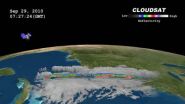(Press-News.org) Tropical Storm Nicole was a tropical storm for around 6 hours before it weakened into a remnant low pressure area and is now off the Florida coast. NASA Satellite imagery captured different views of Nicole's clouds as the system weakened back into a low pressure area.
While Nicole weakened, a huge trough of low pressure over the U.S. eastern seaboard from Florida to Maine has become the key weathermaker there. The trough, an elongated area of low pressure, is streaming tropical moisture from Nicole's remnants and the Gulf of Mexico, bringing high rainfall totals and severe weather up and down the coast.
At 2 a.m. EDT on Sept. 30, Nicole's remnant low was still 35 miles east of Fort Lauderdale, Fla. and about 65 miles west-southwest of Freeport, the Bahamas. Nicole's remnants are forecast to merge with the giant trough (an elongated area of low pressure) later today or early Friday. Nicole's remnants, barely discernable on satellite imagery now because of the huge trough to its west, will still be bringing locally heavy rainfall over the Bahamas. There's just a 10 percent chance it will regenerate as a subtropical cyclone in the next 24 hours.
The GOES-13 satellite captured a visible image of the extensive cloud cover of the trough (elongated area of low pressure) all along the U.S. East coast on Sept. 30 at 1345 UTC (9:45 a.m. EDT) that is feeding off tropical moisture from the Gulf of Mexico, and Nicole's remnants. GOES satellites are operated by NOAA and the NASA GOES Project at NASA's Goddard Space Flight Center, Greenbelt, Md. uses the satellite data to create images and animations.
NASA's CloudSat satellite passed through the western section of Tropical Storm Nicole on September 29, 2010 at 0727 UTC (3:27 a.m. EDT). CloudSat captured an image of the elongated storm system when it was located between Cuba and Florida was in the beginning stages of tropical cyclone formation. CloudSat imagery noticed that low level cyclonic circulation was developing around the low pressure area, as it was being fueled by warm sea surface temperatures.
The CloudSat image captured areas of light cumulus precipitation mixed with a stream of mid- level cloudiness, most likely altocumulus and altostratus. Deep mid-level flow from the south-southwest was evident in the image, occurring from the inclination of the clouds towards the north-northeast.
On Sept. 28 at 18:20 UTC 2:20 p.m. EDT the Moderate Resolution Imaging Spectroradiometer (MODIS) instrument on NASA's Aqua satellite captured a visible image of Tropical Storm Nicole over Cuba before it weakened back into a tropical depression. Nicole was already losing her cyclonic shape at that time.
The National Hurricane Center issued its final official forecast for Nicole on Sept. 29 at 5 p.m. EDT. At that time, Nicole had maximum sustained winds near 40 mph. It was about 175 miles east-northeast of Havana, Cuba and 165 miles west of Nassau near 24.5 North and 80.0 West. It was moving north-northeast near 12
mph and had a minimum central pressure of 996 millibars. At that time, it had degenerated into an elongated area of low pressure and the National Hurricane Center noted that the ill-defined low had become untrackable.
Forecasters are also watching a low pressure area in the eastern Caribbean. A large area of disturbed weather associated with two tropical waves is about 800 miles east of the Windward Islands. The showers and thunderstorms in it are currently disorganized but it is expected to move into more favorable conditions. It currently has a 30 percent chance of becoming a tropical depression in the next 48 hours, so Cuba is watching it closely after being soaked by Nicole.
INFORMATION:
NASA satellites see Nicole become a remnant, another low soaking US East Coast
2010-10-01
ELSE PRESS RELEASES FROM THIS DATE:
Women's study finds longevity means getting just enough sleep
2010-10-01
A new study, derived from novel sleep research conducted by University of California, San Diego researchers 14 years earlier, suggests that the secret to a long life may come with just enough sleep. Less than five hours a night is probably not enough; eight hours is probably too much.
A team of scientists, headed by Daniel F. Kripke, MD, professor emeritus of psychiatry at UC San Diego School of Medicine, revisited original research conducted between 1995 and 1999. In that earlier study, part of the Women's Health Initiative, Kripke and colleagues had monitored 459 women ...
IBEX finds surprising changes at solar boundary
2010-10-01
When NASA launched the Interstellar Boundary Explorer (IBEX) on October 19, 2008, space physicists held their collective breath for never-before-seen views of a collision zone far beyond the planets, roughly 10 billion miles away. That's where the solar wind, an outward rush of charged particles and magnetic fields continuously spewed by the Sun, runs into the flow of particles and fields that permeates interstellar space in our neighborhood of the Milky Way galaxy.
No spacecraft had ever imaged the collision zone, which occurs in a region known as the heliosheath, because ...
NIH scientists describe how salmonella bacteria spread in humans
2010-10-01
VIDEO:
See a time-lapse series showing hyper-replication of Salmonella bacteria (red) in epithelial cells from two to seven hours after infection.
Click here for more information.
New findings by National Institutes of Health scientists could explain how Salmonella bacteria, a common cause of food poisoning, efficiently spread in people. In a study published this week in the Proceedings of the National Academy of Sciences, researchers describe finding a reservoir of rapidly ...
Slicing proteins with Occam's Razor
2010-10-01
A cheetah lies still in the grass. Finally, a gazelle comes into view. The cheetah plunges forward, reaches sixty-five miles per hour in three seconds, and has the hapless gazelle by the jugular in less than a minute. Then it must catch its breath, resting before eating.
A blue whale surfaces, blasting water high from its blowhole. It breathes in great gasps, filling its thousand-gallon lungs with air. Then it descends again to look for krill, staying below for 10, 20, even 30 minutes before taking another breath.
Both animals need oxygen, of course. And both depend ...
Iowa State University researcher examines mosquito gene for new disease response
2010-10-01
Ames, Iowa - An Iowa State University researcher searched for new genes that are turned on during infection in a type of mosquito that is not only a pest, but transmits disease-causing pathogens.
Lyric Bartholomay, assistant professor of entomology, along with colleagues from around the world, infected the common southern house mosquito (Culex quinquefasciatus) with various pathogens to see which mosquito genes are activated in response to the infection.
Bartholomay is the first author on the paper, "Pathogenomics of Culex quinquefasciatus and Meta-Analysis of Infection ...
Short and long sleep in early pregnancy linked to high blood pressure in the third trimester
2010-10-01
DARIEN, IL – A study in the Oct. 1 issue of the journal Sleep found that getting too little or too much sleep in early pregnancy is associated with elevated blood pressure in the third trimester. The study suggests that improving prenatal sleep hygiene may provide important health benefits.
Results show that the mean systolic blood pressure in the third trimester was 114 mm Hg in women with a normal self-reported nightly sleep duration of nine hours in early pregnancy, 118.05 mm Hg in women who reported sleeping six hours or less per night, and 118.90 mm Hg in women ...
Is photoscreening the best way to catch 'lazy eye'?
2010-10-01
SAN FRANCISCO, CA– Amblyopia, known as "lazy eye," is a major cause of vision problems in children and a common cause of blindness in people aged 20 to 70 in developed countries. In amblyopia the person's stronger eye is favored and his/her weaker eye gradually loses visual power as a result. When the condition is detected and treated before age 7, more than 75 percent of children achieve 20/30 vision or better, the Amblyopia Treatment Study reports. But parents and teachers can easily miss this problem–especially in very young children. Pediatric ophthalmologists (Eye ...
Most suicidal adolescents receive follow-up care after ER visits
2010-10-01
SAN FRANCISCO – For suicidal adolescents, the emergency department (ED) is most often the chosen portal to mental health services. New research, presented Friday, Oct. 1, at the American Academy of Pediatrics (AAP) National Conference and Exhibition in San Francisco, looks at what happens to the 30 percent of suicidal adolescents who are discharged from the ED and whether they go on to access additional mental health services.
In "Predictors of Mental Health Follow up Among Adolescents with Suicidal Ideation After Emergency Department Discharge," researchers followed ...
New lung cancer research finds half of advanced lung cancer patients receive chemotherapy
2010-10-01
For the first time to date, research published in the October edition of the Journal of Thoracic Oncology (JTO) sought to determine the use of chemotherapy in a contemporary, diverse non-small cell lung cancer (NSCLC) population encompassing all patient ages. Prior population-based studies have shown that only 20 to 30 percent of advanced lung cancer patients receive chemotherapy treatment. These studies have previously relied on the Medicare-linked Surveillance, Epidemiology, and End Results (SEER) database, thus excluding the 30 to 35 percent of lung cancer patients younger ...
TRUST study data confirms safety and efficacy of erlotinib for advanced lung cancer
2010-10-01
Featured in the October edition of the Journal of Thoracic Oncology (JTO), data from The Tarceva Lung Cancer Survival Treatment (TRUST) confirms the safety and efficacy profile of erlotinib, a highly potent oral active, reversible inhibitor of epidermal growth factor receptor (EGFR) tyrosine-kinase (TK) activity in a large heterogeneous non-small cell lung cancer (NSCLC) population.
Erlotinib has been shown to significantly increase survival for patients with previously treated advanced NSCLC. Certain groups of patients with NSCLC, such as those with a particular type ...



